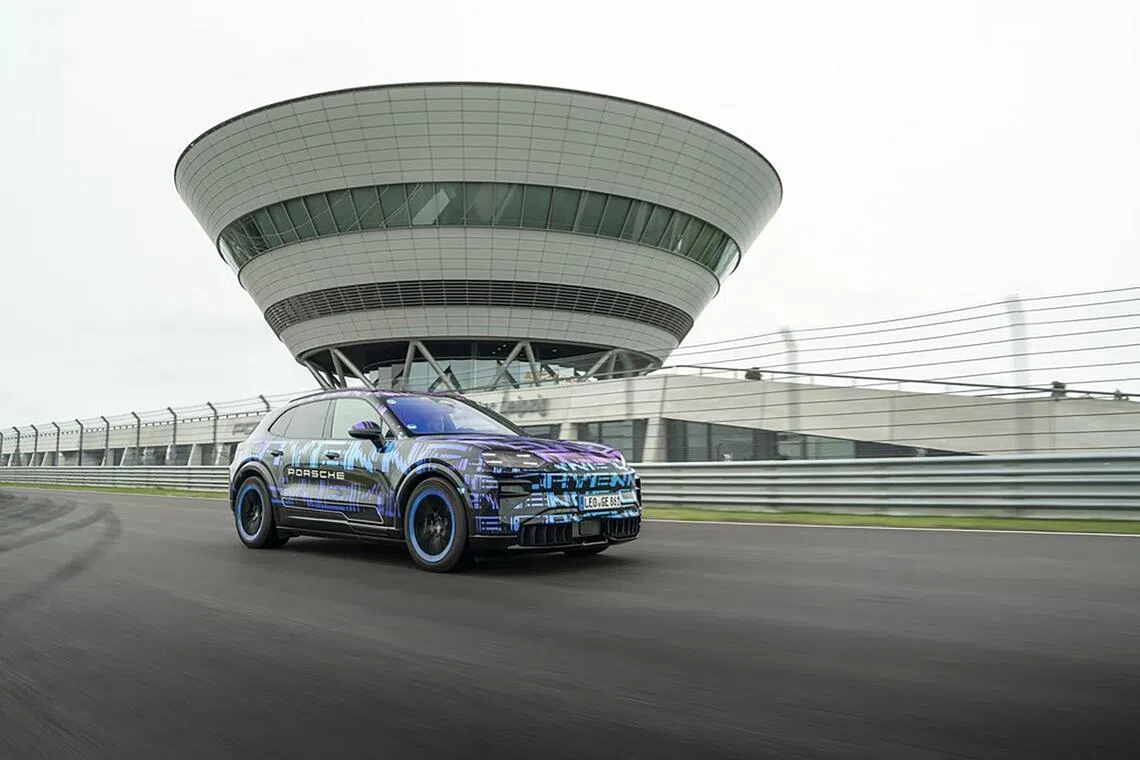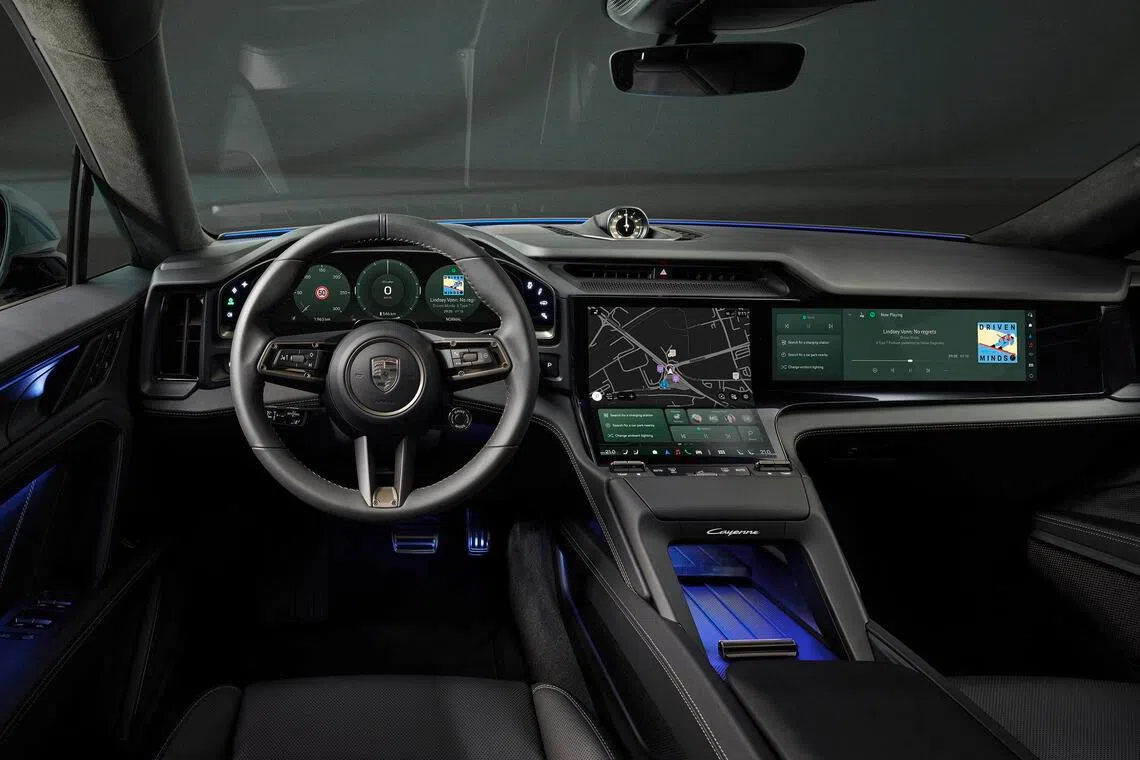Tech Torque: Electric Porsche Cayenne SUV packs supercar-baiting performance
Sign up now: Get ST's newsletters delivered to your inbox

Fast charger: The electric Cayenne packs 900kW of power and takes just three seconds to get from 0 to 100kmh.
PHOTO: PORSCHE
Follow topic:
- Porsche's Cayenne Electric, due in 2026, is declared its most powerful production car, boasting over 800kW power and 1,500Nm torque from its dual-motor, all-wheel-drive system.
- The Cayenne Electric includes a 113kWh battery, giving around 600km of range, and can charge at 400kW, gaining 300km range in 10 minutes.
- Porsche is dialling back its electric model plans due to weak demand and will continue combustion engine and hybrid models into the 2030s.
AI generated
LEIPZIG, Germany – More than 20 years ago, Porsche introduced the Cayenne, the first non-sports car in the German brand’s history. The large sport utility vehicle (SUV) came to be Porsche’s all-time bestseller with around 1.5 million units delivered to date.
So successful was the Cayenne that it prompted Porsche to create a smaller SUV, the Macan.
The large SUV was available with conventional petrol and diesel engines that powered all four wheels. Plug-in hybrid versions were added later on.
Come mid-2026, the first fully electric Cayenne will arrive. Ahead of the global unveiling expected later in 2025, The Straits Times takes a high-speed passenger ride in a prototype to get the lowdown on some of the car’s technical highlights.
1. Supercar level of performance
Porsche has declared the Cayenne Electric its most powerful production car. The dual-motor, all-wheel-drive electric car will have more than 800kW of power and at least 1,500Nm of torque. Around 66 per cent of that power comes from the motor on the rear axle.
Activating the push-to-pass feature liberates an additional 100kW, bringing peak power output to as much as 900kW, albeit momentarily.
While the motor’s output and performance figures are still provisional at this stage, Porsche expects the Cayenne Electric to go from 0 to 100kmh within three seconds and the large SUV will continue accelerating, hitting 200kmh in under eight seconds, putting it in the territory of top-tier sports cars.
At 98 per cent efficiency, the electric motor used is said to be more efficient than the 90 to 95 per cent efficiency of those in current electric cars.
The motors are able to propel the SUV to a maximum speed of 250kmh using a single-speed reduction ratio, instead of a two-speeder like the Porsche Taycan and the mechanically identical Audi e-tron GT.
The 113kWh battery is good for around 600km of driving range. The car has a maximum charging speed of 400kW, enabling the battery pack to absorb enough energy in 10 minutes to gain 300km of driving range.
In Singapore, where the most powerful station is rated at 200kW, a 10-minute charge would give roughly 150km of range.
The chassis underpinning the Cayenne Electric is new and it features the Porsche Electronic Traction Management system and suspension control. Air suspension is standard for the Cayenne Electric.
The prototype at Porsche’s test track at Leipzig, Germany, is equipped with the optional active suspension. From the passenger seat, with a professional driver behind the wheel, the large SUV feels very capable on the track.
2. Record energy recuperation
The Cayenne Electric, known internally as the E4, can recover energy during braking at a rate of 600kW, which Porsche says is a world-first. What we do know is that this is about three times higher than existing electric cars.
Mr Marco Schmerbeck, director of the Cayenne’s energy systems, says this enables the electric car to rely more on its motors working in reverse to slow down the car. The friction brakes, which involve brake pads pressing on the discs, do kick in during full retardation, but Mr Schmerbeck says the driver will not be able to tell the transition between the two types of braking.
3. Digital cabin
Porsche is using the Cayenne Electric to debut its new virtual dashboard layout. It consists of a curved display for the driver, a touchscreen that stretches from the face of the dashboard to the base of the sloping centre console, earning it the name “Flow Display”.

More screen time: The Cayenne Electric features digital displays stretching across the entire width of the dashboard.
PHOTO: PORSCHE
The screen also extends across to serve the front passenger, where it can be used to control the infotainment – such as running videos and playing music – and other app functions.
Overheard
There will be a second Cayenne that will use a platform and body that are different from the electric model. This will be powered by combustion engines with hybrid technology.
This is in line with the company’s announcement on Sept 19 that it is dialling back its electric model plans because of weaker demand, pressure in key markets like China and higher US tariffs.
Mr Oliver Blume, chief executive of Porsche, told media that production of combustion engine and hybrid models, including the Panamera, will continue into the 2030s.
The company plans to launch a new SUV that sits above the Cayenne, which will initially be offered with combustion engine and hybrid models.
Porsche’s share price fell following the news, but staff at the Cayenne preview event in Leipzig are confident that investor confidence will be restored when the new cars hit the road.

